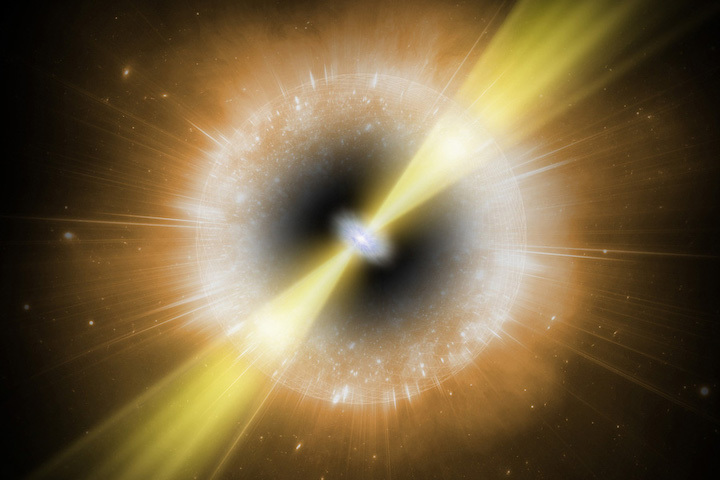15.12.2021
Astronomers have identified the origin of a mysterious flash that occurred three years ago.

An artist’s impression of the mysterious burst AT2018cow.
National Astronomical Observatory of Japan
A titanic explosion in a remote galaxy, observed in June 2018, was most likely the birth cry of a neutron star or a black hole, according to detailed analysis of high-energy X-rays from the fading blast.
Discovered by the ATLAS sky survey and catalogued as AT2018cow, the explosion occurred in a spiral arm of the inconspicuous galaxy CGCG137-068, at 200 million light-years distant in the constellation Hercules. But this was no regular supernova: “The Cow”, as it was nicknamed, brightened much faster, and was much bluer and more luminous than any exploding star observed before.
Similar “fast blue optical transients” (FBOTs) had been found in archival data, but the Cow was the first one seen in real time, and by far the most luminous one ever observed. Back then, astronomers thought the flash might be due to powerful shocks in dense gas clouds surrounding an exploding giant star, or to a white dwarf star being ripped apart and devoured by an intermediate-mass black hole.
However, in today’s Nature Astronomy, a team led by Dheeraj Pasham (MIT) argues against both those scenarios. Pasham and his colleagues analyzed two months’ worth of high-energy X-ray data from the mystery source, collected by NASA’s Neutron Star Interior Composition Explorer (NICER) X-ray telescope aboard the International Space Station. The astronomers found a rapid flickering, believed to originate close to a compact object.
From the observed frequency of the signal (224 cycles per second), the authors estimate the X-ray emitting region to be no larger than 1,300 kilometers (800 miles) across, ruling out an extended gaseous envelope as the source. And given this size constraint, if the central compact object is a black hole, it can’t be more massive than 850 solar masses — incompatible with being a medium-mass black hole snack.
The X-ray flickering isn’t perfectly regular. The precise origin of such high-frequency quasiperiodic oscillations (QPOs) is unknown, but there’s little doubt that they arise close to a compact object, most likely in a rapidly rotating accretion disk. Similar signals from around known stellar-mass black holes suggest a relation between black hole mass and QPO frequency; if the same relation holds for AT2018cow, its black hole would weigh in at about 4 solar masses.
Then again, the authors stress that the compact object could also be a neutron star, spinning 224 times a second. One thing appears to be clear, though: given the stability of the QPO signal over a period of 60 days (corresponding to more than a billion cycles), the Cow’s luminosity cannot be due to the rapid spin-down energy of a highly magnetized neutron star, known as a magnetar.
“The authors have done a very thorough job in exploring different options, and I agree with their results,” says magnetar expert Chryssa Kouveliotou (George Washington University). “I think it is still too early to call what the spinning object is. We probably need to observe more such systems to make a final decision.”
The good news is that NICER might watch luminous FBOTs like the Cow every three years or so. As Pasham and his colleagues write in their paper: “Similar signals in future FBOTs could allow astronomers to study infant compact objects immediately after birth.”
Quelle: Sky&Telescope
